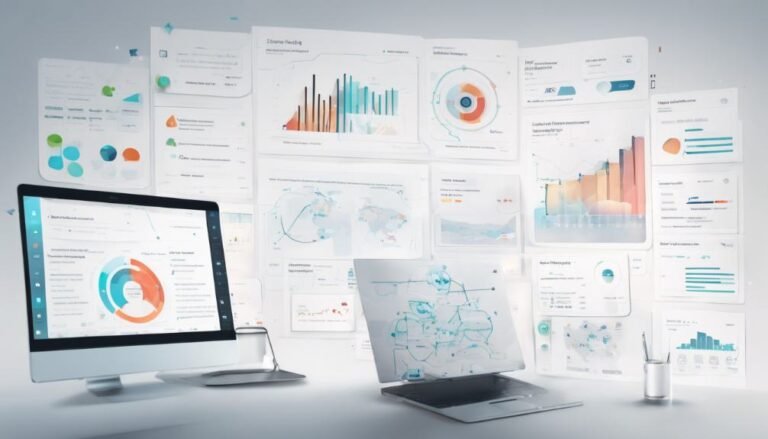AI in Trading and Investment: A Comprehensive Guide
In today's complex financial landscape, the exploration of AI in trading and investment has rapidly gained traction, transforming traditional methodologies and strategies. As the lines between human decision-making and machine learning blur, the application of AI in finance offers a myriad of possibilities, from predictive analytics to risk mitigation strategies. With a focus on enhancing trading efficiency and optimizing investment returns, this guide delves into the intricate web of AI applications in trading and investment, shedding light on the future of financial markets and the evolving role of technology in shaping investment landscapes.
Key Takeaways
- AI analyzes market trends using advanced algorithms and machine learning.
- AI assists in making data-driven investment decisions by identifying patterns in historical data.
- Predictive analytics in AI forecasts future market trends for informed decision-making.
- AI optimizes trading strategies for better returns through real-time decision-making.
- AI enhances risk management by automating processes, optimizing portfolios, and gauging market sentiment.
Role of AI in Trading
AI plays a pivotal role in trading by utilizing advanced algorithms to analyze market trends and make data-driven investment decisions with speed and precision. Machine learning, a subset of artificial intelligence, enables trading systems to learn from historical data, identify patterns, and make predictions based on new information. This technology empowers traders to leverage vast amounts of data efficiently, leading to more informed decision-making processes.
Predictive analytics, another key component of AI in trading, uses historical data, statistical algorithms, and machine learning techniques to forecast future market trends. By analyzing various data points and market indicators, AI systems can predict potential price movements, identify trading opportunities, and manage risks effectively.
Incorporating machine learning and predictive analytics into trading strategies enhances accuracy, reduces human error, and increases the speed at which decisions are made. This data-driven approach enables traders to capitalize on market opportunities in real-time, ultimately improving overall trading performance.
Types of AI in Finance
In the domain of finance, different types of artificial intelligence technologies are employed to enhance trading and investment strategies. Machine learning plays an essential role in analyzing vast amounts of financial data to uncover patterns and trends that can inform decision-making.
Financial modeling, another key AI application, enables the creation of sophisticated models to predict market behavior and assess risk.
Sentiment analysis is utilized to gauge market sentiment by analyzing news articles, social media posts, and other sources of information to understand how public perception may impact asset prices.
Predictive analytics, on the other hand, leverages historical data to forecast future market movements and optimize investment portfolios.
These AI technologies provide traders and investors with valuable insights, helping them make more informed decisions and potentially gain a competitive edge in the financial markets.
AI-Powered Trading Strategies
Advanced algorithms and computational techniques are increasingly shaping the landscape of modern trading strategies, with a focus on harnessing artificial intelligence for efficient decision-making. Machine learning and predictive analytics play crucial roles in developing AI-powered trading strategies. These strategies utilize historical data, market trends, and various indicators to make informed investment decisions in real-time. Through the use of sophisticated algorithms, AI can analyze vast amounts of data at speeds far beyond human capability, enabling traders to identify patterns and potential opportunities that may otherwise go unnoticed.
| Machine Learning | Predictive Analytics | AI-Powered Strategies |
|---|---|---|
| Trains models to recognize patterns in data | Utilizes historical data to forecast future trends | Utilizes AI algorithms to make real-time trading decisions |
| Adapts to changing market conditions | Helps in risk assessment and mitigation | Enhances decision-making processes |
| Enables automated trading based on learned patterns | Improves accuracy in predicting market movements | Optimizes trading strategies for better returns |
Risk Management With AI
Utilizing sophisticated algorithms and computational techniques, the integration of artificial intelligence in trading strategies not only enhances decision-making processes but also plays a pivotal role in optimizing risk management strategies.
AI enables more precise portfolio optimization by analyzing vast amounts of data to identify the ideal asset allocation that maximizes returns while minimizing risks. Through advanced risk analytics, AI can assess historical market trends, current market conditions, and various risk factors to proactively manage potential risks in real-time, allowing for a more adaptive and responsive risk management approach.
Additionally, sentiment analysis, a key component of AI, aids in gauging market sentiment and investor behavior by analyzing news articles, social media, and other textual data to understand market dynamics better. By incorporating sentiment analysis into risk management strategies, traders and investors can make more informed decisions by considering not just quantitative data but also qualitative factors that influence market movements.
Impact of AI on Markets
AI has greatly impacted markets through its ability to analyze market volatility, develop complex algorithmic trading strategies, and automate risk management processes.
Market volatility analysis using AI has enabled more accurate predictions and better risk assessment.
Additionally, algorithmic trading strategies powered by AI have enhanced trading efficiency and reduced human errors in decision-making.
Furthermore, the automation of risk management processes has improved overall market stability and provided a more systematic approach to managing risks in trading and investment.
Market Volatility Analysis
Market volatility analysis has become increasingly important with the integration of advanced algorithms and machine learning models in financial markets. Historical data analysis and predictive modeling play a vital role in evaluating market volatility trends.
By analyzing past market behavior, AI systems can identify patterns and relationships that help predict future volatility levels. Additionally, sentiment analysis is utilized to gauge market participants' emotions and reactions, providing insights into potential shifts in volatility.
Event correlation, another key aspect, involves examining how various events impact market volatility. AI algorithms excel at processing vast amounts of data to identify correlations between events and market fluctuations, enhancing the accuracy of volatility predictions.
Algorithmic Trading Strategies
The integration of advanced algorithms and machine learning models in trading has revolutionized market dynamics by greatly influencing the development and execution of algorithmic trading strategies. Quantitative modeling plays a pivotal role in algorithmic trading, enabling traders to analyze vast amounts of data and make informed decisions based on statistical and mathematical models. Backtesting these strategies against historical data is vital to assess their effectiveness and potential profitability.
High-frequency trading (HFT) is a subset of algorithmic trading that involves executing a large number of orders at extremely high speeds. HFT relies heavily on algorithms to identify and capitalize on market inefficiencies in milliseconds. While HFT can enhance market liquidity and efficiency, there are concerns about its potential to manipulate markets due to its speed and volume of trades. Regulators closely monitor HFT activities to prevent market manipulation and uphold fair trading practices.
Risk Management Automation
Risk management automation in trading has become increasingly sophisticated with the integration of AI technologies, reshaping how market participants assess and mitigate potential financial risks. This advancement has greatly enhanced the effectiveness and efficiency of risk management processes in trading and investment domains.
Key aspects influenced by AI technologies in risk management include:
- Portfolio Diversification: AI algorithms can analyze vast amounts of data to optimize portfolio diversification strategies, ensuring a more balanced and resilient investment approach.
- Behavioral Finance: By utilizing machine learning techniques, AI systems can recognize and factor in behavioral biases in decision-making processes, leading to more rational and less emotion-driven risk management practices.
- Quantitative Analysis: AI enables the automation of quantitative analysis tasks, allowing for quicker and more accurate risk assessments based on complex mathematical models and historical data patterns.
Through the integration of machine learning and quantitative analysis, AI-driven risk management automation is revolutionizing how financial risks are identified, evaluated, and managed in modern trading environments.
AI in Investment Decision-Making
How can artificial intelligence (AI) be leveraged to enhance the precision and efficiency of investment decision-making processes?
Machine learning applications play a significant role in revolutionizing how investment decisions are made. By utilizing AI algorithms, investors can analyze vast amounts of data to identify patterns and trends that may not be apparent through traditional analysis methods. This data-driven approach enables more informed investment strategies, leading to improved decision-making and potentially higher returns.
AI excels in data analysis, allowing it to process and interpret complex financial data at a speed and scale that surpasses human capabilities. By leveraging AI for investment decisions, investors can automate tasks such as portfolio optimization, risk assessment, and asset allocation. These capabilities streamline the decision-making process, reduce human bias, and enhance the overall efficiency of investment management.
Furthermore, AI can adapt to changing market conditions in real-time, providing investors with up-to-date insights to make informed decisions promptly. By integrating AI into investment strategies, investors can gain a competitive edge in the dynamic and fast-paced financial markets.
Future Trends in AI Trading
Artificial intelligence is poised to shape the future of trading with emerging trends that are revolutionizing the investment landscape. As technology advances, AI forecasting and market prediction are becoming increasingly sophisticated, offering traders and investors powerful tools to make data-driven decisions.
Machine learning plays a pivotal role in enhancing market analysis, enabling algorithms to analyze vast amounts of data quickly and identify patterns that human traders may overlook.
- AI-Powered Trading Strategies: AI-driven trading strategies are gaining traction, allowing for more efficient and effective decision-making in complex market environments.
- Enhanced Risk Management: AI tools are being utilized to assess and mitigate risks in real-time, providing traders with valuable insights to protect their investments.
- Algorithmic Trading Evolution: The evolution of algorithmic trading is accelerating, with AI algorithms continuously learning and adapting to market conditions to optimize trading outcomes.
Conclusion
To summarize, AI in trading and investment plays a vital role in revolutionizing the financial landscape by employing advanced algorithms and machine learning to analyze market trends, make data-driven investment decisions, and predict future market movements.
One example of this is how AI-powered trading strategies have been shown to outperform traditional human traders in terms of accuracy and efficiency, leading to improved returns and better risk management in dynamic financial environments.







